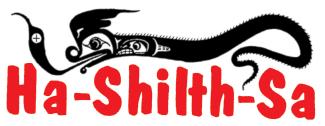

INTERESTING NEWS

Rain quiets Mount Underwood fire to ‘smouldering’
Electricity outage to last up to two weeks for Bamfield area and Nitinaht, six kilometres of power line damaged
By Eric Plummer Ha-Shilth-Sa Editor
What began as an explosive wildfire that sent a mushroom-cloud-like plume of smoke above PortAlberni is now a steaming, charred mountain slope –thanks in large part to rain after three days of concerning growth.
As on Monday,Aug. 18, 144 wildfire personnel were on Mount Underwood, digging up the smouldering remains of the forest fire to expose and extinguish the still burning undergrowth. The Mount Underwood blaze emerged at about 6:30 p.m. onAug. 11, rapidly growing up the mountain slope that overlooks the China Creek Campground and Marina. By Friday that week Mount Underwood had grown to over 3,400 hectares, making it the largest forest fire Vancouver Island has seen in years. The fire is currently reported to cover 3,603 hectares, and remains the only “wildfire of note” in British Columbia, according to the B.C. Wildfire Service.
Mount Underwood is still listed as “out of control”, but its behaviour has clearly eased, as has the weather. Over the wildfire’s first two days of activity temperatures in theAlberni Valley rose to the mid 30s, but by the afternoon of Thursday, Aug. 14 the rain started, continuing through the next few days as the weather cooled. By Monday,Aug. 18, the B.C. Wildfire Service reported 36 millimetres of rain has fallen on the wildfire.
“This precipitation has reduced fire behaviour to primarily Rank 1 – smouldering ground fire with some open flame,” stated the wildfire service. “Shorter days, longer nights, and higher relative humidity will continue to support stronger overnight recoveries.”
KiahAllen is operations chief for the Mount Underwood fire with the B.C. Wildfire Service. In an update onAug. 17 she said crews were working to establish a 100-foot-wide area at the edge of the fire with “100 per-cent extinguishment”.
“They’re starting with mop up, and they’re going to be putting out, extinguishing hot spots within a certain area to the perimeter of the fire,” she said. “What that allows us to do is ensure that there’s not going to be a flare up that starts somewhere outside of the perimeter, or that’s not going to flare up and have flame lengths that go overtop the guard.”
Nineteen pieces of heavy equipment are also on the scene, digging trenches outside Mount Underwood’s perimeter to prevent future spread.
On the wildfire’s east flank three 20-person unit crews worked towards each

other to contain smouldering north of the Franklin River.
“Crews have established an anchor point on the northwest flank,” reported the wildfire service. “Three unit crews are working south along the west flank and eastward along the north flank to build containment.”
Over this week fire activity on Mount Underwood was expected to remain low, as higher temperatures aren’t forecasted to return until Thursday or Friday.
The nearby road from PortAlberni to Bamfield has been closed since the evening that the fire broke, with no indication on when it will reopen. This section of Franklin River Road passes through an evacuation order that was issued for the China Creek Campground and Marina.
OnAug. 20 this order was downgraded to an alert, allowing people to return to the facility.
Awidespread power outage has cut off electricity to Bamfield,Anacla and the Ditidaht First Nation community of Nitinaht sinceAug. 11. BC Hydro reports that the wildfire caused extensive damage to power poles and lines that run to these small communities.
In an update issued onAug. 16 the provincial utility cautioned that power restoration could up to two weeks.
“Fifty-six power poles, along with associated wire and hardware, will need to be replaced,” stated BC Hydro. “Crews will need to restring 70 spans of power line – roughly 20 kilometres in total. The rebuild will cover six kilometres, including two kilometres of particularly difficult terrain marked by steep forested cliffs and unstable rock.”
Three crews are at the location to undertake power restoration, plus 10 vegetation workers and four pole-digging machines.
Mount Underwood is south of PortAlberni, but with the road closed, these crews need to travel from Duncan, accessing from the other direction along logging roads that are adding two hours of travel time each way to their daily workload. Besides the evacuation order for the China Creek facility and the area of the wildfire, alerts were issued onAug. 13 by theAlberni-Clayoquot Regional District for areas at the south end of PortAlberni. These include the city’s Cameron Heights neighbourhood, a portion of the Cherry Creek electoral area and the Tseshaht reserve at Polly’s Point. On 20 these alerts were lifted.
During a press conference on the day the alerts were issued, PortAlberni Mayor Sharie Minions assured residents that the city was “not in imminent danger,” but encouraged people to have essentials ready if any evacuation orders are given.
“We want people to always be prepared for a possible evacuation,” she said, noting that the alerts were issued as a precaution only.
While Mount Underwood has died down for the time being, how the wildfire affected life over its first week is destined to remain in the collective memory of the region’s residents. Smoke filled the Alberni Inlet, bringing concerning levels to fine particulate matter into the atmosphere that prompted businesses to close and outdoor events to be cancelled. On Friday,Aug. 15 at 1 p.m. the volume of fine particles reached 268 per cubic metre, according to data from a monitoring
station atAlberni Elementary. This is ten times higher than the provincial standard of an average 25 fine particles per cubic metre over a 24-hour period.
“People more likely to be negatively impacted by outdoor air pollution should reduce or reschedule strenuous activities outdoors or seek medical attention if experiencing symptoms,” stated Island Health in an air quality advisory. “This includes people aged 65 and older, pregnant individuals, infants and young children, people with an existing illness or chronic health condition such as chronic obstructive pulmonary disease (COPD), heart disease and diabetes, and people who work outdoors.”
Remarkably, the China Creek Campground and Marina remained untouched by the forest fire. In a public statement, the facility’s management thanked wildfire fighters for their efforts, and has allowed these personnel to stay in the China Creek cabins and guesthouse as they attend to Mount Underwood.
Meanwhile, south of the fire residents of the communities without power are relying on generators and emergency supplies. For the Ditidaht First Nation, help came from across the Juan de Fuca Strait, where their relatives in the Makah Tribe live in Neah Bay, Washington. The Makah gave several generators to the Nitinaht community.
“Your donation of generators, cords, lighting, and supplies brought light, comfort, happy tears, and hope to our community when we needed it most,” said the Ditidaht First Nation to the Makah. “Your generosity shows the strength of our Nations when we stand together.”
Eric Plummer photo
Rain dampens the Mount Underwood wildfire on Friday,Aug. 15, a weather change that has eased the behaviour of the blaze south of PortAlberni.
Tlu-piich Games cancelled due to wildfire smoke
The 40th annual sporting event was cut short after two and a half days, as air quality reached concerning levels
By Nora O’Malley Local Journalism Initiative Reporter
PortAlberni, BC – The 2025 Tlu-piich Games were shut down halfway through the 3x3 basketball tournament at EJ Dunn Elementary School due to the encroaching smoke from the Mount Underwood wildfire.
Les Doiron, Nuu-chah-nulth Tribal Council (NTC) vice president, delivered the bad news to a gymnasium packed with hungry ballers at around 12:30 p.m., Aug. 13.
“We’ve never seen smoke like this in the valley before. It’s dangerous, right. Ditidaht, they’ve got no power. It’s for the safety of all of our People,” said Doiron.
“Can we just finish our game?” one of the young players asked.
Doiron was kind but firm, re-iterating that it’s to keep people safe, plus outof-town nations will have more time to make their way home.
Ditidaht cultural support worker Samantha Edgar says 40 people from Ditidaht journeyed to PortAlberni for the games on Sunday, the day before the wildfire was discovered.
Ditidaht is a remote First Nations community on the southwest of Vancouver Island on Nitinaht Lake about two hours driving distance from PortAlberni. Its main access road, the Bamfield Main, is closed as crews battle the wildfire. The road closure also impacts the Huu-ay-aht First Nations community ofAnacla and the town of Bamfield.
“I just got word that we might be without power for up to seven weeks. It’s been really hard. I’m worried about
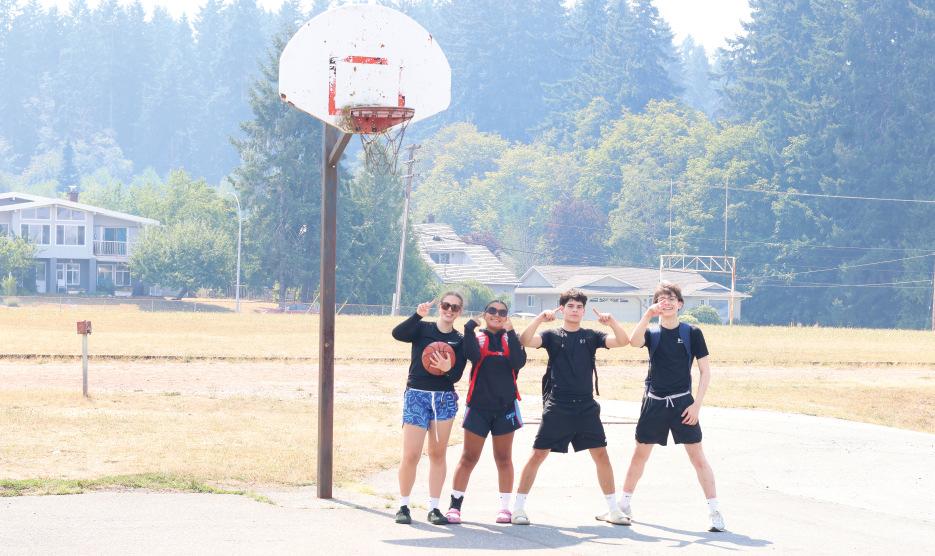
Dogs team from left: Wiinuk Martin, Brielle
went for a swim after the 3x3 tournament was cancelled.
everyone that’s at home in the community because there are still lots of people there. They’re all working together down there, making sure everyone is ok. Daly’s Gas station from Youbou is delivering gas to the members,” said Edgar moments after the Tlu-piich Games ended.
Edgar went on to say that she was working on getting their hotel bookings extended.
Yuułuʔiłʔatḥ citizen Tyson Touchie was refereeing the morning basketball games.
“Pretty much everyone showed up,” said Touchie. “You know how West Coast ballers are, they play or die, it doesn’t matter.”
But with ash from the wildfire falling on the softball pitch the day before, Touchie says everyone kind of knew the call would be coming.
Last year’s 3x3 Tlu-piich champions the Hot Dogs were on their way to defend their title with a cheeky 24-22 win over Ahousaht’s U17 team.
“Everyone was playing for second,” Hot Dogs player Vaugh Robinson joked in the parking lot as all the Nuu-chah-nulth teams packed up.
“Shout out to our rides. The people who bring us here,” added player Wiinuk Martin.
NTC executive also closed all Port Alberni offices for the next two days in the interest and well-being of staff health and safety.

Nora O’Malley photo
Hot
Tom, Vaughn Robinson and Cassius Robinson
Concern misinformation sparks unnecessary panic
Due to heavy smoke, wildfire personnel didn’t always know how much the Mount Underwood blaze spread
By Eric Plummer Ha-Shilth-Sa Editor
PortAlberni, BC -Arapidly growing wildfire south of PortAlberni sent a current of anxiety through the community, leading officials to caution residents to be selective in their sources of information to avoid unnecessary panic.
First emerging at about 6:30 p.m. on Monday,Aug. 11, the Mount Underwood wildfire burned at an explosive rate, growing to 3,406 hectares in less than three days. This brought the evacuation of the nearby China Creek Campground and Marina as well as the closure of the road that runs through the evacuation zone from PortAlberni to Bamfield. Since that Monday evening the communities of Bamfield,Anacla and Nitinaht have been without power.
Besides the order to leave the China Creek facility and other spots in the vicinity of the blaze, an evacuation alert was issued onAug. 13 for the Tseshaht reserve at Polly’s Point and the southern PortAlberni neighbourhood of Cameron Heights.
Although “the fire has spread closer to the community,” this alert does not mean residents of these areas should leave, stressed PortAlberni Mayor Sharie Minions.
“We don’t feel that there is any imminent threat, otherwise we would be issuing additional alerts and orders,” she said during a press conference on Thursday,Aug. 14. “This is an alert only and means residents should be prepared to leave on short notice, but nobody is required to leave, nobody needs to leave imminently.”
Thick smoke hindered the ability of the BC Wildfire Service to know how big the spread actually is. For a day the extent of Mount Underwood’s perimeter wasn’t clear.
“We know that there has been growth, we’re working find that perimeter right now,” said Stefan Hood, the B.C. Wildfire Service’s incident commander for Mount Underwood and Wesley Ridge, during the morning press conference. “Access is a real challenge. We’ve got several roads that have been impacted by the fire. Debris from the fire has been compromising

Hood (second from the
the safety of travelling those roads.”
Meanwhile, as is often the case with public emergencies, social media has been the quickest source of information – although the accuracy of what is being reported has been inconsistent.
Along with the City of PortAlberni and theAlberni-Clayoquot Regional District, the Tseshaht First Nation declared a state of emergency. The First Nation has been disseminating information about the wildfire from official sources, but what members are relying on remains a concern.
“The biggest thing going on right now is misinformation,” said Tseshaht Councillor Les Sam during the press conference.
“We need to deal with facts and not fiction on this fire.”
“We’re constantly getting sent weird maps, Tick Toks, information that’s not from here, photos where they zoomed right in, going ‘It’s right on the top of the mountain!’I can look at it from my backyard, it’s not there,” added Brandy Lauder, chief councillor of the Hupacasath First Nation. “Try to keep people
calm. There’s always room to be prepared and ready, but there’s no real need as of yet to panic.”
Online tools, such as MODIS and FIRMS, use satellites to detect heat sources, producing maps for hot spots in the area of the Mount Underwood wildfire. These can be accessed by the public, but might not provide an accurate picture of where the forest fire exactly is, advised Hood.
“What it’s really showing is the heat source. The heat source is the flames on the ground, but it’s also the smoke in the air,” he said. “That shouldn’t be misrepresented as being an accurate mapping tool of where the perimeter of the fire currently is.”
By 3 p.m. that afternoon the expected rain began to fall in the region.After a week that began with temperatures in the mid 30s, this brought a welcome change for the firefighters. Rain continued through the weekend.
“It’s not going to put out the fire, but it should help us in terms of limiting fire growth for a period of time until it
gets warm again,” said Hood. “We have a lot of heavy fuel out there. Rain will only buy us some time to get our crews in there, get heavy equipment in there to construct some guards and then work from those anchor points.”
Mount Underwood is currently the province’s only “Wildfire of Note”, and by Thursday,Aug. 14 an incident management team assumed control, overseeing over a hundred firefighters on the ground, with additional structural protection specialists and tree fallers. Eleven helicopters are also being used - including two with night vision technology – plus heavy equipment to clear debris and help establish a fire guard.
“We have all sections represented from operations, planning, logistics, finance, safety and info,” said Hood of the specialized team he is leading. “It’s a collection of skilled individuals. We come together from all parts of the province and find ourselves often at the most challenging and the most impactful fires in the province.”
Fine particle level spikes in Alberni during wildfire
By Eric Plummer Ha-Shilth-Sa Editor
PortAlberni, BC -Aug. 13 brought a dramatic spike in levels of fine particulate matter, as the Mount Underwood forest fire spread thick smoke through the Alberni Valley and beyond.
The wildfire first emerged at approximately 6:30 p.m. on Monday,Aug. 11, sending a mushroom cloud of smoke above Mount Underwood, which is near the China Creek Campground and Marina and south of PortAlberni. Over its first day of burning winds trended south, but byAug. 13 this shifted to the north, sending thick smoke to the nearby City of PortAlberni.As of midday on Thursday, Aug. 14 Mount Underwood had grown to 3,406 hectares, according to the BC Wildfire Service.
Environment Canada has issued a health advisory due to the particulate matter in the air.
“As smoke levels increase, health risks increase. Limit time outdoors. Consider
reducing or rescheduling outdoor sports, activities and events,” stated the advisory.
“You may experience mild and common symptoms such as eye, nose and throat irritation, headaches or a mild cough. More serious but less common symptoms include wheezing, chest pains or severe cough. If you think you are having a medical emergency, seek immediate medical assistance.”
By the afternoon of Wednesday,Aug. 13 the thick smoke led to the cancellation of the Tlu-piich Games, two and a half days into the annual Nuu-chah-nulth sporting event. By 2 p.m. that day the volume of fine particles per cubic metre reached 145.9, according to data from an air monitoring station atAlberni Elementary. This is well above the standard of 25 fine particles per cubic metre that the province uses as an acceptable average volume of contaminants in the atmosphere over a 24-hour period. Levels last spiked onAug. 4 to 55 fine particles, as crews battled another nearby wildfire that burned on the north side of Cameron
Lake.
As of 11 a.m. on Thursday,Aug. 14 the average volume of fine particles over the previous 24-hour period was 28.71, but this level shot up over the following evening. By 1 p.m. on Friday,Aug. 15
fine particulate matter had reached 268 per cubic metre – a level 10 times greater than the provincial standard.
Deb Haggard, vice-chairperson of the Alberni-Clayoquot Regional District, advised residents to close their doors and windows if the air is smoky.
“Conditions vary from hour to hour, I’ve noticed in the morning it’s a lot worse,” she said during a press conference on Thursday. “It can cause health risks, especially for children, older adults and people with heart or lung conditions. We ask that you recognize this and please stay inside.”
Efforts were underway to open a reception centre for those who don’t have a home, said PortAlberni Mayor Sharie Minions.
“There are many residents of the city
of PortAlberni who are vulnerable and many are unhoused,” she said. “The regional district and the city are jointly working on opening up a reception centre to have a drop-in area for those members of our community to make sure that they are cared for as well and that they have reprieve from the smoke.”
Mount Underwood is currently the only incident designated as a “Wildfire of Note” in B.C., and the largest forest fire Vancouver Island has seen in recent years. Winds have spread its smoke beyond theAlberni Valley, and existing wildfires like Wesley Ridge at Cameron Lake have also affected air quality across British Columbia. On Thursday,Aug. 14 Canada Post announced that mail delivery or pick up would not be happening in Parksville, Qualicum Beach and Nanoose Bay due to air quality concerns. Delays in mail service are also expected in Port Alberni and Nanaimo.
Eric Plummer photo
Stefan
left), the B.C. Wildfire Service’s incident commander for Mount Underwood, speaks with other officials during anAug. 14 press conference.
Ha-Shilth-Sa newspaper is published by the Nuu-chah-nulth Tribal Council for distribution to the members of the contributing First Nations, as well as other interested groups and individuals.
Information and original work contained in this newspaper is protected by copyright and may not be reproduced without written permission from:
Nuu-chah-nulth Tribal Council P.O. Box 1383, PortAlberni, B.C. V9Y 7M2.
Telephone: (250) 724-5757
Fax: (250) 723-0463
Web page: www.hashilthsa.com
facebook: Hashilthsa Ntc
2025 Subscription rates:
Non-Nuu-chah-nulth,Ahousaht, Ehattesaht,Toquaht and Ucluelet members are subject to a yearly subscription fee of $40 in Canada, $50 in the US and $60 for overseas. Payable to the Nuu-chah-nulth Tribal Council
Manager/Editor/Reporter
Eric Plummer (Ext. 243) (250) 724-5757 Fax: (250) 723-0463 eric.plummer@nuuchahnulth.org
Reporter
Denise Titian (Ext. 240) (250) 724-5757 Fax: (250) 723-0463 denise.titian@nuuchahnulth.org
Reporter Nora O’Malley (604) 353-8488 nora.omalley@nuuchahnulth.org

Audio / Video Technician
Mike Watts (Ext. 238) (250) 724-5757 Fax: (250) 723-0463 mike.watts@nuuchahnulth.org
EditorialAssistant
Holly Stocking (Ext. 302) (250) 724-5757 Fax: (250) 723-0463 holly.stocking@nuuchahnulth.org
DEADLINE:
Please note that the deadline for submissions for our next issue is Aug. 29, 2025
After that date, material submitted and judged appropriate cannot be guaranteed placement but, if material is still relevant, will be included in the following issue.
In an ideal world, submissions would be typed rather than hand-written. Articles can be sent by e-mail to holly.stocking@nuuchahnulth.org (Windows PC).
Submitted pictures must include a brief description of subject(s) and a return address.
Pictures with no return address will remain on file.Allow two - four weeks for return.
Photocopied or faxed photographs cannot be accepted.
COVERAGE:
Although we would like to be able to cover all stories and events, we will only do so subject to:
- Sufficient advance notice addressed specifically to Ha-Shilth-Sa.
- Reporter availability at the time of the event.
- Editorial space available in the paper.
- Editorial deadlines being adhered to by contributors.
LETTERS and KLECOS
Ha-Shilth-Sa will include letters received from its readers. Letters MUST be signed by the writer and have the writer’s full name, address and phone number on them. Names can be withheld by request.Anonymous submissions will not be accepted. We reserve the right to edit submitted material for clarity, brevity, grammar and good taste. We will definitely not publish letters dealing with tribal or personal disputes or issues that are critical of Nuu-chah-nulth individuals or groups. All opinions expressed in letters to the editor are purely those of the writer and will not necessarily coincide with the views or policies of the Nuu-chah-nulth Tribal Council or its member First Nations. Ha-Shilth-Sa includes paid advertising, but this does not imply Ha-Shilth-Sa or Nuu-chah-nulth Tribal Council recommends or

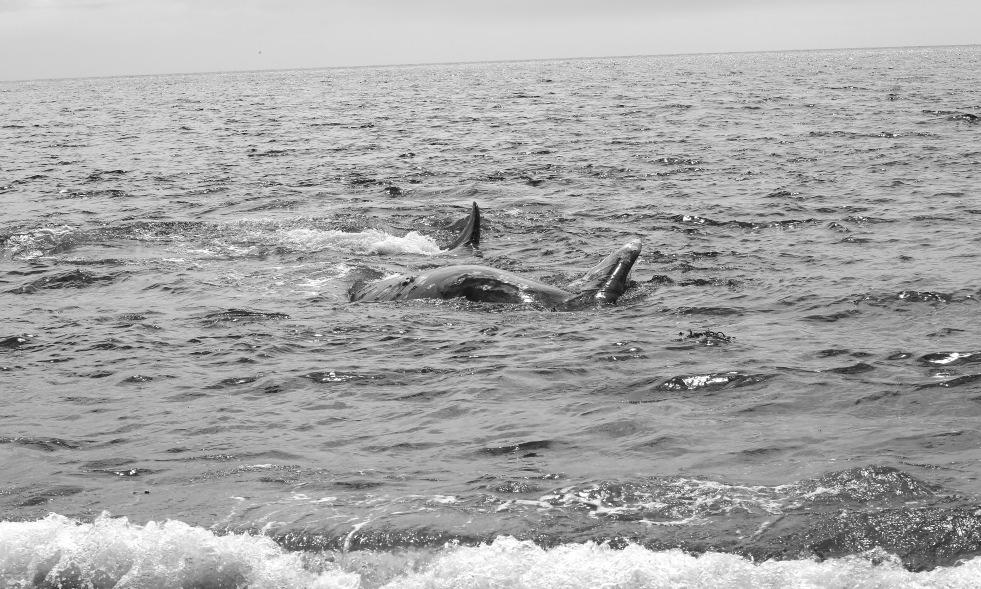
Whale report shows abundance off coast
Humpbacks are gathering in large numbers off Vancouver Island’s southwest coast
By Olivia Thomas Ha-Shilth-Sa Contributor
Ucluelet, BC –Anew three-year study led by the Yuułuʔiłʔatḥ Government has confirmed what local knowledge keepers have long observed: large whales, including humpbacks, gray whales, and orcas, are present year-round in the waters off the west coast of Vancouver Island. The findings, however, come with a warning: Increasing marine shipping traffic is intersecting with critical whale habitat, raising the risk of collisions and other human impacts.
From March 2022 to June 2025, the Yuułuʔiłʔatḥ Government’s Fisheries and Wildlife program carried out one of the most extensive aerial whale monitoring efforts ever conducted in the region. Flying twice a month over Barkley Sound, Swiftsure Bank, and the continental shelf, researchers recorded more than 3,000 whale sightings across 70 surveys. Humpback whales dominated the counts, with nearly 1,400 individuals observed, often gathering in large numbers along nutrient-rich upwelling zones. Gray whales were most common in the sum-
mer months along shallow feeding areas, while endangered southern resident killer whales and transient orcas were spotted at Swiftsure Bank and farther offshore. Less common but significant findings included fin, sei, minke, and even sperm whales.
The surveys also revealed troubling signs.At least one sperm whale carcass and a gravely injured fin whale were documented. Researchers frequently noted humpbacks, fins, and orcas surfacing directly in major vessel corridors, highlighting what the reports calls “increasingly common” conflict between whales and shipping traffic.
The study builds on long-standing Indigenous knowledge and supplements gaps left by federal surveys, which are often limited to summer months. Consistent, year-round monitoring revealed whale presence during overlooked periods such as during early spring herring spawning events and December humpback migrations.
The findings are expected to inform future marine stewardship and policy decisions, especially as shipping traffic through Vancouver Island’s offshore
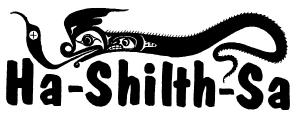
Ha-Shilth-Sa belongs to every Nuu-chah-nulth person including those who have passed on, and those who are not yet born.Acommunity newspaper cannot exist without community involvement. If you have any great pictures you’ve taken, stories or poems you’ve written, or artwork you have done, please let us know so we can include it in your newspaper. E-mail holly.stocking@nuuchahnulth.org. This year is Ha-Shilth-Sa’s 51st year of serving the Nuu-chah-nulth First Nations. We look forward to your continued input and support. Kleco! Kleco!
waters continues to grow. The report emphasizes the need for data-driven mitigation measures, such as vessel speed reductions, route adjustments, and greater protection of critical feeding areas.
In the future whales could face a higher risk of collisions with vessels – particularly oil tankers that pass by southwest Vancouver Island. On May 1, 2024 the Trans Mountain Expansion Project was completed, increasing the pipeline capacity of petroleum product from central Alberta to the Vancouver area by nearly three-fold. This was projected to increase the number of oil tankers receiving shipments from the pipeline from five to as many as 34 a month. This would represent a 14 per cent overall increase in the volume of marine traffic from the Port of Vancouver, although since its completion Trans Mountain has yet to operate at capacity.
The full report, Year-Round Abundance Monitoring of Large Whales Throughout the Yuułuʔiłʔatḥ Government & Maanulth Nations’ Southern Marine Territory (2022–2024), is now complete and contributes to a growing body of Indigenousled marine research on the West Coast.
Legal Information
The advertiser agrees that the publisher shall not be liable for damages arising out of errors in advertisements beyond the amount paid for space actually occupied by the portion of the advertisement in which the error is due to the negligence of the servants or otherwise, and there shall be no liability for non-insertion of any advertisement beyond the amount paid for such advertisements
Eric Plummer photo
Agrey whale rolls in the surf at Yuquot onAug. 16. Grey whale sightings off the Vancouver Island coast were most common in the summer months along shallow feeding areas, according to a new report.
Heatwaves greatly affect marine ecosystems
Over two years 240 species were found outside their usual geographic boundaries, while kelp forests collapsed
By Sam Laskaris Ha-Shilth-Sa Contributor
Arecently published report led by University of Victoria (UVic) researchers reveals ocean heatwaves significantly impact marine ecosystems.
The research, published in Oceanography and Marine Biology:AnAnnual Review, is concerning for many, including Nuu-chah-nulth First Nations, since it also includes information on how future ocean warming will have additional negative impacts.
For this report, researchers focused on a period from 2014 through 2016, when NorthAmerica’s Pacific coast experienced the longest marine heatwave ever. Temperatures were as many as six degrees higher than previous historical averages.
During their work researchers pored over information available in a total of 331 government reports and primary studies.
This research found that during this particular heatwave a total of 240 different species were found outside their usual geographic boundaries.
It was also determined the heatwave caused massive kelp and seagrass declines.As a result, numerous kelp forests collapsed.
“We documented widespread shifts in species distributions, declines in critical habitats like kelp forests and eelgrass meadows, and cascading effects on food webs, fisheries, and species like marine mammals and birds,” said Sam Starko, a former UVic postdoctoral fellow and the lead author of the research.
Starko said some of the details obtained caught the researchers themselves off guard.
“One of the most surprising findings was just how widespread and interconnected the impacts were,” Starko said, adding that entire ecosystems were destabilized.
Starko explained how some ripple effects occurred.
“The largest seabird die-offs ever observed in the North Pacific occurred during this heatwave but were caused by changes in the food web rather than direct effects of temperature,” he said.
“The abundance and availability of forage fish declined because of the warm water, which in turn led to starving sea birds. The scale and persistence of some of these changes, even years after the heatwave, was alarming.”
Julia Baum, a marine ecologist and special advisor on climate at UVic, believes the report is rather beneficial.
“As heatwaves become more frequent

“We documented widespread shifts in species distributions, declines in critical habitats like kelp forests and eelgrass meadows, and cascading effects on food webs, fisheries, and species like marine mammals and birds,” says Sam Starko, a former UVic postdoctoral fellow and the lead author of the research.
and intense under climate change, the 2014-16 Northeast Pacific marine heatwave provides a critical example of how climate change is impacting ocean life and how our future oceans may look,” she said. “This study underscores the urgent need for proactive, ecosystembased marine conservation strategies and climate change mitigation measures.”
While most species experienced negative impacts from the warming ocean, Starko said some species did benefit, primarily either because their predators declined or because they are better suited to warmer waters.
Starko said sea urchins were among those that benefitted.
“Mussels and barnacles increased in some northern areas, likely due to reduced competition from seaweeds that were negatively impacted in those areas and less predation by sea stars,” Starko added. “Anumber of subtropical fish and invertebrates were also found further north than ever before, which may be considered a benefit to them if they are able to spread across a larger geographic area.”
Starko believes information gleaned during the research should be concerning, including for those from Nuu-chah-nulth First Nations.
“The territories of the Nuu-chah-nulth Nations were directly affected by the marine heatwave,” he said. “Local kelp forests declined, such as those in Huu-ayaht territory in Barkley Sound.”
Starko said there were additional impacts as well.

“Sea stars were lost to disease across the entirety of Vancouver Island and several warm water species moved into the waters off of the west coast of Vancouver Island for the first time,” he said. “These changes affect both biodiversity as well as culturally and economically important resources, such as fisheries.”
Starko added there were poor returns of salmon in some areas and evidence of reduced food availability for them.
As heatwaves and ocean warming continues, Starko said steps can be taken to alleviate problems.
“Ongoing monitoring, protecting areas from additional stressors (like pollution) that can compound with the impacts of warming or protecting areas that may act as climate refuges could benefit marine life,” he said.
Additionally, habitat restoration efforts might assist to restore some lost areas. Starko said an example of how this could be accomplished would be the removal of urchins to restore kelp forests, which in the short term could help preserve biodiversity.
Starko said another measure could also be taken.
“Incorporating Indigenous knowledge into marine planning is an equally important step because it offers deep, place-based understanding of ecosystems, potentially providing early warnings of change, context for interpreting scientific data, and holistic perspectives on stewardship that are essential for effective climate adaptation,” he said.
Sabrina Crowley, a regional biologist for Uu-a-thluk Fisheries, said Nuu-chahnulth Nations are keenly aware of changing conditions and witnessing climate change impacts first-hand within their territories.
“With the already impacted natural salmon runs due to habitat damage and overfishing, climate change is another stressor for the salmon species to overcome migrating in these changing ocean conditions,” she said.
Crowley said steps are being taken to help alleviate concerns.
“Being aware and monitoring the changing conditions, such as studies like this plus monitoring our aquatic resources, assists in managing our resources which the Nations have been doing in their territories for quite some time,” she said.
Candace Picco, a senior biologist with the Ha’oom Fisheries Society, also said concerns about the impacts of climate change is an ongoing worry from Nuuchah-nulth First Nations.
“Our most immediate concern in terms of warming waters is the challenges to migrating salmon in the rivers and estuaries where the water responds faster to the hot weather,” she said. “Changes in precipitation patterns and warm waters stress spawning adults, potentially making them less reproductively successful and causing juveniles to emerge too early, impacting marine survival and salmon resiliency.”


Wesley Ridge forest fire classified as ‘being held’
Some evacuation orders lifted for Li le Qualicum River, as B.C. Wildfire Service hoped for rain in mid August
By Nora O’Malley Local Journalism Initiative Reporter
Twelve days after it was first reported, BC Wildfire Service (BCWS) classified the Wesley Ridge wildfire at Cameron Lake as being held, according to a Monday,Aug. 11 update.
BCWS said there was no growth on the Wesley Ridge wildfire over the previous day.
“The fire displayed mostly Rank 1 fire behaviour, which is a smouldering ground fire with no open flame. There were isolated pockets of Rank 2, which is a low-vigour surface fire with some visible flame and Rank 3, which is a moderately vigorous surface fire with visible flame,” states BCWS.
Evacuation orders for 257 properties in Little Qualicum River Village were also downgraded to an EvacuationAlert.
Douglas Holmes, the Regional District of Nanaimo’s chief administrative officer and emergency operations director, said while it’s still a day-to-day situation, things are trending in a positive way.
“Thank you everyone involved, in particularly the front-line firefighters both in the forest and those people protecting the structures. You’ve done amazing, heroic work and all the people supporting our evacuees from the bottom of our hearts, we say thank you,” said Holmes in an Aug. 11 media update.
The remaining 37 properties in Little Qualicum River Village above 1726 Warn Way remained on Evacuation Order, but by midAugust this was lifted. The 353 properties that were already on alert below 1726 Warn Way and near the Spider Lake area remained on EvacuationAlert until the third week ofAugust.
Holmes said worked in co-ordination with BC Parks and BCWS to get areas that are closed open as soon as possible.

Aunit crew with the BC Wildfire Service boards a boat on Cameron Lake onAug. 10.
As of midAugust, the boat launch at Horne Lake Regional Park remained closed, Little Qualicum River Regional Park was closed as a precautionary measure and the day-use area at Cameron Lake was closed.
“In regards to the use of the lake, we are still using it for wildfire suppression activities and this goes for any lake in the area. If you are using a lake, if it is open, and you see wildfire suppression aircraft coming in, please move to shore. Allow them space to work. If you are in their area, if you are in their way, they can’t work and it does hamper their ability,” said BCWS fire information officer Madison Dahl.
With temperatures pushing over 30°C in PortAlberni over the second week ofAugust, heat advisories were given to crews working on the Wesley Ridge wildfire.
“The outlook is for hot and dry conditions to persist until Wednesday (Aug. 13), when we will see a shift back to more seasonal temperatures. The current high-pressure ridge will break down Thursday and Friday, bringing the potential for some much-welcomed precipitation,” says BCWS.
“I would add, that it is very hot out, but we are very fortunate to have a number of lakes available to us including lakes like Sproat Lake,” said Holmes, “if you can find a public access to the ocean, please
consider other alternatives in this time while we focus on firefighting efforts.”
BCWS re-iterated that “boats in sight delay our flight”, and interference with firefighting operations is not only dangerous, it also violates the WildfireAct.
“Recreational boaters or people using other watercraft who try to get a closeup look at the aircraft present a serious safety risk to air crews, themselves and anyone else in the area. This behaviour also affects our ability to fight a fire or practice safely, since aircraft cannot collect water when a boat is in the intended flight path. Boat wakes can also pose a danger to water scooping aircraft,” explained BCWS.

BC Wildfire Service photo
Free Indigenous music festivals ready to rock Island
The Vancouver Island tour starts on Aug. 23 in Macoah, Aug. 26 in Ahousaht and Aug. 30 in ‘Yalis at Alert Bay
By Nora O’Malley Local Journalism Initiative Reporter
Vancouver Island, BC – For the second year running, 2 Rivers Remix Society (2RMX) and VirtualFeast.ca are bringing a free Indigenous music, art and culture festival to three communities on Vancouver Island.
Dubbed ‘Movable Feast’, the Island tour launches on Saturday,Aug. 23 in the Toquaht Nation community of Macoah in western Barkley Sound, followed by Ahousaht on Tuesday,Aug. 26, and ending in ‘Yalis (Alert Bay) on Saturday, Aug. 30.
Attendees can expect to see live contemporary music performances alongside traditional songs and dances, with food and market vendors at each Movable Feast event. Each Movable Feast opens at noon with a welcoming ceremony from the local nations and elders, as well as a special opening ceremony by Mexika-Tenochka artistsAna Cornejo and Leo Vara.
“Our island trek reaffirms the connections of our ocean water peoples as it was before colonization,” said 2RMX artistic director Meeka Morgan in a media release.
“It is a living example of how difficult it is for our people to gather since being forcibly placed onto inaccessible lands. Yet, through this journey we bring together inter-nation relatives, friends, allies, and survivors of residential schools, many of whom have not seen one another in over 60 years, all through music and art, which are integral to our ways and values as Indigenous peoples on Mother, the Earth… as it was before,” said Morgan, who is of Toquaht and Secwépemc descent and a member of the hip hop group The Melawmen Collective.
The tour showcases a talented line-up of Indigenous artists from Canada and beyond, including: multi-instrumentalist, singer-songwriter, two-time 2024 JUNO WinnerAysanabee (Oji-Cree), Leonard Sumner, anAnishnaabe poet and singer/ songwriter from Little Saskatchewan First Nation, and the resident elder artist

and Inuvialuit folk-rock legend Willie Thrasher and Linda Saddleback.
“Thrasher was born inAklavik, Northwest Territories, in 1948 and at five years of age, Thrasher was taken from his family and sent to a residential school where he was forbidden to practice his Inuvialuit culture. Music was a way for Thrasher to escape the pain and longing,” reads his artists’bio.
Local Nuu-chah-nulth performers include Hasaatuk (Nuu-chah-nulth/Cree) and Kiva MH (Nuu-Chah-Nulth/Secwépemc). Each festival will close with a live DJ set; ‘Yalis will see DJ Kookum (Alexis Nakota Sioux Nation),Ahousaht and Toquaht will see Handsome Tiger (Anishinaabe/Métis/NorthAfrican).
Movable Feast/2RiversRemix stems
from Lytton, B.C., a community that has a large Indigenous population with half the town on federal reserve lands.
“We saw the need for an all-Indigenous led and centred event where survivors feel safe and the inter-generations can witness one another’s artist expressions in a really high-quality production,” Morgan shared in a past interview with the Ha-Shilth-Sa.
2RMX was going strong for two years until the COVID-19 pandemic came along, and that’s when they started the livestreaming and pre-recording.
“And then 2021 came and the fire took out the whole town,” Morgan continued. She said they lost all their equipment, art exhibitions, everything.
“That would have ended most organiza-
said Sadler. Instead, 2RMX completely re-invented themselves into the Movable Feast, “a nimble and small-roving music festival with a commitment to sustainability”, as event promoter Sadler describes. Movable Feast uses a fleet of electric vehicles and an LED wall for lighting.
“It’s amazing,” said Sadler. “Their idea was to hit every First Nation in B.C., or as many as possible, and to do cultural sharing in community with community as one day and the next day being the music festival.”
She encouraged folks to pre-register for the free Indigenous concerts by visiting VirtualFeast.ca, where the performances will also be livestreamed to promote accessibility.
Black bear killed by unidentified driver in Pacific Rim
By Nora O’Malley Local Journalism Initiative Reporter
Long Beach, BC – Parks Canada is reminding drivers to slow down after a black bear was struck and killed by a vehicle onAug. 10 in the Pacific Rim National Park Reserve.
The bear was hit on the Pacific Rim Highway 4, in the middle of the day, just north of the Tla-o-qui-aht First Nations community of Ty-Histanis.
“The driver of the vehicle involved is unknown,” said Todd Windle, Parks Canada human-wildlife coexistence team lead, in an email statement.
“There is no charge for accidentally striking wildlife with a vehicle. If, however, a driver was found to be speeding, driving recklessly, or intentionally harming wildlife, related charges could apply. In this case, as noted, the driver remains unidentified,” Windle continued.
Parks Canada is working together with Tla-o-qui-aht First Nation (TFN) to assist in cultural protocols and necropsy of the bear.
“We are looking to receive the hide for use in regalia and cultural items. We will also look to render bear grease if it will be possible,” said TFN Natural Resources
Manager Saya Masso.
With respect to the necropsy, Parks Canada says these examinations help determine if an animal had underlying conditions, assess overall wildlife health, and support ongoing education and conservation work.
For this particular necropsy, Parks Canada has reached out to TFN to participate in the examination, if desired. Parks Canada says they will share any learning that results from the necropsy with Tla-oqui-aht.
Windle confirmed that there are bear fatalities on Highway 4 almost every year.
“Obey speed limits and be aware of road conditions while visiting Pacific Rim National Park Reserve. Slowing down helps protect wildlife and others on the road,” said Windle.
The speed limit in the Pacific Rim National Park Reserve is 90 kilometres an hour and 60 kilometres an hour or less on secondary roads and active construction zones, as posted.
It’s been a deadly summer for bears on the west coast with B.C. conservation officers killing four food-conditioned black bears in the region to ensure public safety.
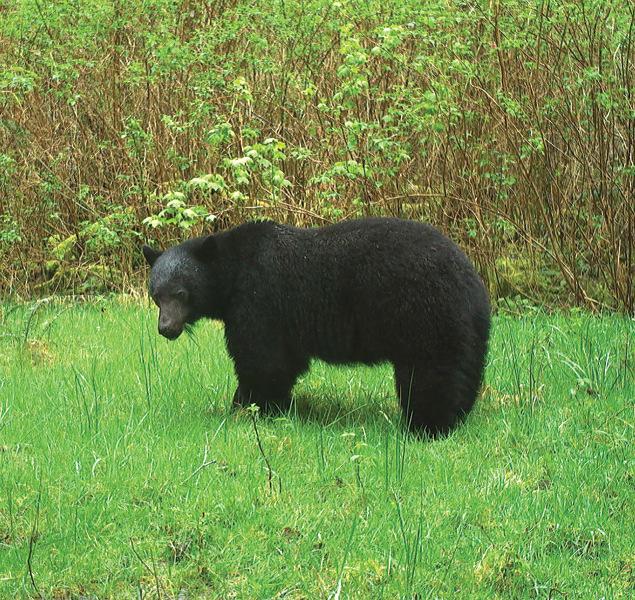
2 Rivers Remix Society photo
Festival-goers dance during last years’Movable Feast concert in the Toquaht Nation community of Macoah, which overlooks western Barkley Sound. tions,”
Parks Canada photo
Aremote wildlife camera caught this black bear eating grass in the Pacific Rim National Park Reserve.
Violent August in PA with three suspicious deaths
‘I’m
concerned for just how violent it is here’, says RCMP detachment commander to Port Alberni City Council
By Nora O’Malley Local Journalism Initiative Reporter
PortAlberni, BC – Three suspicious deaths in earlyAugust have created public unease in PortAlberni, a city of over 18,000 located within the traditional territories of the Hupacasath and Tseshaht First Nations on Vancouver Island.
OnAug. 1, PortAlberni RCMP responded to a report of a suspicious fire in the 2000 block of 16thAvenue. Firefighters were on scene putting out the fire and performing life saving measures on an adult male resident, police said, and an adult female was located suffering from fire and smoke related injuries.
Both victims were transported to hospitals outside of the community, police said. The male later died from his injuries, and the female remains in hospital in stable but serious condition, according to anAug. 6 statement from the Port Alberni RCMP.
Then onAug. 6, local police found human remains inside a burned vehicle in the 3700 block of 4th Avenue. Investigators are seeking anyone with information or dashcam footage in the area between the times of 2 a.m. and 4 a.m. that same day to come forward.
On the following weekend PortAlberni RCMP received a report of an assault near the intersection of Johnston Road and Victoria Quay onAug. 10. That call came in at 12:42 a.m., which led police to locate a man suffering from serious injuries. He was transported to hospital but succumbed to his injuries despite life-saving effort, police said.
“PortAlberni RCMP General Investigation Section has assumed conduct of this ongoing investigation and is working to determine the circumstances that led to the man’s death. Based on the initial information this death is being treated as suspicious,” states the RCMP in anAug. 12 release. “Anyone with any information, CCTV or dash cam video, is urged to contact the PortAlberni RCMP at 250-723-2424.”
PortAlberni RCMP Insp. Kim Bruce provided a second quarter report to mayor and council onAug. 11, going over crime statistics fromApril, May and June 2025.
From Q1 and Q2, Bruce said the calls for service volume increased by 20 per
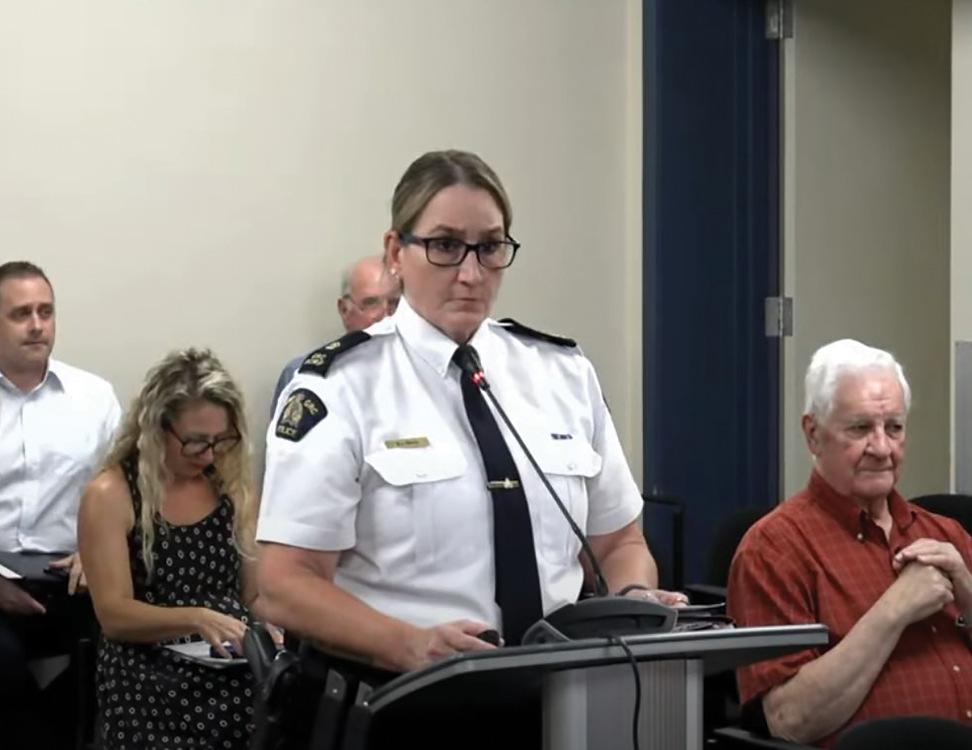
Alberni RCMPInsp. Kim Bruce provided a second quarter report to mayor and
statistics fromApril, May and June 2025. cent and a two per cent higher call volume from the same time last year, or 67 more calls for service than in 2024.
“We’re currently at 6,508 calls for service and as I state, presume no change, we’ll be higher than last year,” said Insp. Bruce.
They later introduced Stats Canada Crime Severity Data for 2024 that showed a notable 20 per cent decrease for PortAlberni and neighbouring communities.
“This is a bit of an area of inquiry for me and I’m continuing to work on it,” said Insp. Bruce. “I’ve tried to reach Stats Can a couple of times because I’d like to know where we’re seeing the improvement or benefit to what’s happening in our community, or if it’s just simply complaint fatigue and we’re not getting the people reporting the crimes in the same
way that they used to,”
“I really don’t know why we’re seeing that decrease because I can attest to as I stand here that there is no discernable change in PortAlberni’s severity of crime. In fact, I’m concerned for just how violent it is here,” Bruce continued. According to Stats Can, the 2023 average provincial crime rate was 65 reported incidents per 1,000 population. The average crime rate for B.C.’s municipal RCMP policing jurisdictions over 15,000 population was 85 reported crimes per 1,000 population. PortAlberni’s crime rate was 179.
Speaking solely of a homicide that occurred in June at Dry Creek Park in Port Alberni, Insp. Bruce said the investigation is “arduous, challenging, very time consuming” and would be prioritized against other tasks.
OnAug. 7, PortAlberni RCMP members arrested William Shane Watts for the alleged homicide that occurred in Dry Creek Park on June 16. The following day, BC Prosecution Service approved a charge of murder for Watts, said police. Watts remains in custody.
During theAug. 11 regular council meeting, PortAlberni Mayor Sharie Minions voiced her appreciation for the detailed crime report and the hard work of the local police.
“We know that there’s some real challenges everywhere. I think the community is growing more concerned as we start to hear some of the specific cases that are happening. So, appreciate the hard work and difficult conditions that you’re working under right now,” said Minions.
RCMP seeking witnesses after body found inside car
Nora O’Malley Local Journalism Initiative Reporter
Police are seeking witnesses after a body was found inside burned vehicle in the early morning hours onAug. 6.
“PortAlberni RCMP members were called to the 3700 block of 4thAvenue to assist the PortAlberni Fire Department with a vehicle fire. Once the fire was extinguished, PortAlberni RCMP officers located unidentified human remains within the vehicle,” reads a statement issued by RCMP onAug. 7.
“Investigators are seeking anyone with information or dashcam footage in the area between the times of 2:00 a.m. and 4:00 a.m. that same day to come forward. No further details are available at this time,” the statement continues.
Anyone with information is asked to contact PortAlberni RCMP at 250-7232424.
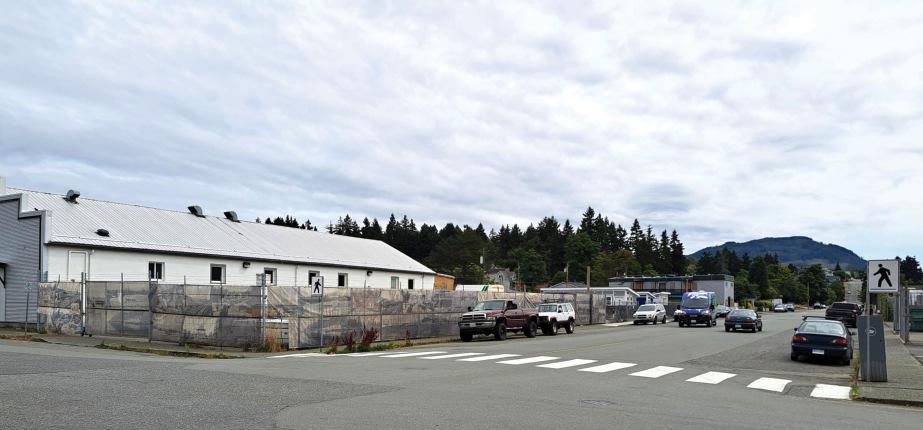
City of Port Alberni video still
Port
council onAug. 11, going over crime
Holly Stocking photo
Abody was found inside a burned vehicle on the 3700 block of 4thAvenue in PortAlberni onAug. 6.
Video sparks reaction amid trying summer for RCMP
Port Alberni commander says context must be considered, after onlookers shout insults at officers during arrest
By Eric Plummer Ha-Shilth-Sa Editor
PortAlberni, BC-Awidely seen online video of a man being beaten on the ground and arrested has sparked outrage among some PortAlberni residents, but police have responded to say that the larger context of the situation must also be considered.
Police report that a 33-year-old man was arrested on Sunday,Aug. 17, after they were called to a business on the 3900 block of 8th Avenue “to remove an individual who was unwanted”. This area has two shelter facilities and the RCMP detachment.
The person was already being sought by police for breaching a court order, and when the officers arrived he fled.Achase ensued, ending in a nearby in an alley between 6th and 7th Avenue.
“It is alleged that the suspect then assaulted the police officer who had caught up to him and a physical struggle ended up on the ground with the suspect keeping his hands underneath his body,” stated the RCMP in a media release.
Seen 1.5 million times with over 7,600 shares through Facebook, a video of incident shows the man being taken down by two officers, held face down on the ground. The footage documents the man being struck by one of the officers, including three times in the side and back of the head with an elbow.As the male officer holds down the man and handcuffs him, a female officer restrains his legs and assists in the arrest.
“During the process of the arrest, police observed a sharp object in the suspect’s hands, and he was not complying with his arrest,” stated the RCMP. “Police had to use force to gain compliance and prevent further injuries.”
Asharp object is not clearly visible in the video, but other items are taken from the man as he’s being restrained.Athird officer soon comes into view, who puts on latex gloves and picks up some things from under the restrained man, including something inside a Ziplock bag.
As the struggle ensues in the video, several people can be heard yelling explicative-laden insults at the officers.
“Hey, we see you,” shouts one woman.
“Hey, we got you on camera you f*cker,” shouts a man.
“We’ll see you on the news channel, you f*cking idiots,” says another man.
Following the arrest the individual was held at the RCMP detachment for a future court appearance.
On the evening of the arrest Ha-ShilthSa received an email from a person claiming to be the man’s sister, saying that he was “smashed” with an elbow multiple times when on the ground “and could not fight back”.
“While use of force by police in any arrest may be disturbing to onlookers, it is important to look at the totality, rather than the result,” said Inspector Kim Bruce, detachment commander for the PortAlberni RCMP, in a statement issued by police. “The Criminal Code provides us with the authority to use force, and it is not something we take lightly.”
The video is being circulated amid a particularly trying summer for the Port Alberni RCMP. The warmer months have brought four suspicious deaths, so far resulting in at least one charge of homicide. Earlier this month police announced a murder charge against William Shane Watts for an alleged homicide that occurred in Dry Creek Park on June 16.

An arrest occurred in a PortAlberni alley onAug. 17, showing a suspect being struck by an officer. The RCMPhave stated that a sharp object was in the man’s hands. “Police had to use force to gain compliance and prevent further injuries,” says the RCMP.
Three other suspicious death investigations took place inAugust, incidents in which police asked for the public’s assistance to bring forward any valuable information.
OnAug. 11 Insp. Bruce gave an update to PortAlberni City Council from the “resource constrained” detachment.
“I’m concerned for just how violent it is here,” she said during the city council meeting.
During her update Bruce informed about a PortAlberni crime rate more than double the provincial average, with an inordinate number of Crown submissions in the small city.As of the end of June, 2025 has brought 493 submissions from the PortAlberni RCMP to the Crown for sentencing, more than the larger urban areas of Campbell River and the Comox Valley. Over the same period of this year Nanaimo - a city triple the size of the Alberni Valley - had 666 submissions to the Crown.
“I think the community is growing more concerned as we start to hear some of the specific cases that are happening,” said PortAlberni Mayor Sharie Minions.
“The number of offenders released on conditions to this community places the burden for enforcing those conditions on our police force,” said Bruce. “Our ability to enforce conditions is greatly diminished by increasing summer call volumes that create operations pressures elsewhere.”
“We can see 15 to 20 checks occur in a night, and at least half of those are persons found to be in breach of their conditions,” added the police inspector.
As the workload continues, a statement from the City of PortAlberni notes that “the mayor wishes to express full confidence in the dedicated efforts of our local RCMP detachment. Their team is actively investigating the circumstances
surrounding these events, and we trust in their professionalism and commitment to ensuring the safety of our community.”
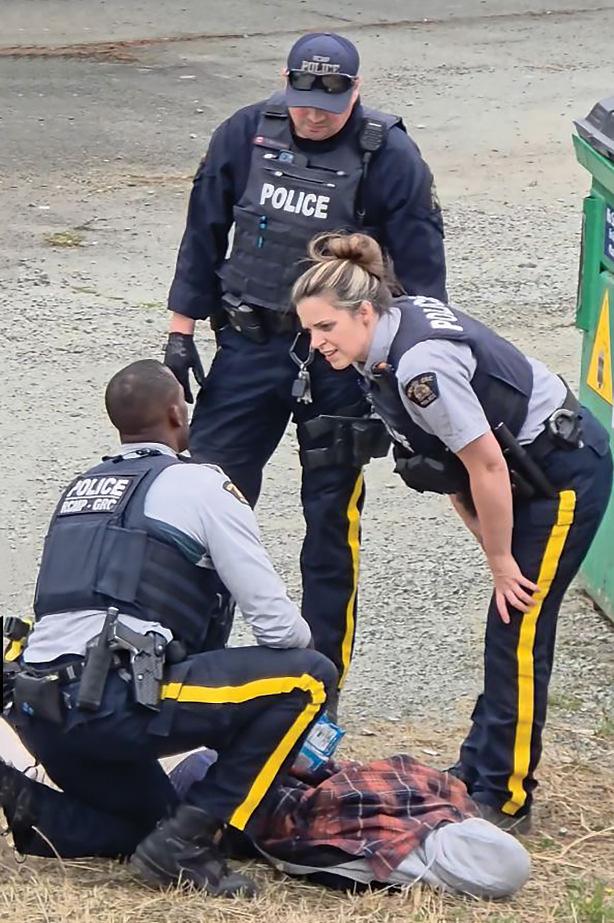
Facebook video still
Artists work on signs with Clayoquot Biosphere Trust
Dennis Hetu and Ivy Martin bring traditional teachings to new welcome signage around Tofino and Ucluelet
By Nora O’Malley Local Journalism Initiative Reporter
Vancouver Island, BC – Nuu-chahnulth artists Dennis Hetu and Ivy Martin teamed up with the Clayoquot Biosphere Trust (CBT) on the west coast of Vancouver Island to bring traditional teachings to new welcome signage peppered throughout the region.
Installed near the Tofino-Ucluelet Junction, Hetu’s latest carving titled Eclipse of the Hunter’s Moon – a project he worked on with his students from the Toquaht Carving School – can be viewed from the multi-use path.
Carved using traditional and modern tools with store-boughtAbalone shell inlays, Eclipse of the Hunter’s Moon portrays two wolves hunting during a lunar eclipse.At night, Hetu’s red cedar carving illuminates with a touch of glowin-the-dark epoxy resin behind the moon.
“Alot of my carvings have to do with species at risk,” said Hetu, who was a big part of Parks Canada’s WildAbout Wolves project and will be featured in the upcoming documentary ‘QʷAYAĆIIK’, meaning wolf in Nuu-chah-nulth, directed by Sam Rose Phillips.
“I have a very personal connection with the wolves in Toquaht Territory. I relate to the wolf. I do everything in my power to protect them and bring information about them (to the public), so people start to view them as non-threatening. In my opinion, the wolf is a species at risk. It’s legal to hunt them, which is a sad, sad thing for me. It’s terrible,” he continued.
According to the Ministry of Water, Land and Resource Stewardship, the 2025-2026 regulations give hunters an annual “bag limit” of three wolves provincewide, which includes Vancouver Island.Abag limit is the maximum number of a specific animal species that a hunter is legally allowed to harvest within a given licence year.
B.C. residents do not require a speciesspecific licence to hunt wolves and can legally hunt wolves with a basic hunting licence. This is subject to other conditions, such as the Gulf Islands Special Licence and associated requirements, said the ministry. Non-residents are required

to purchase both a $75 non-resident licence as well as a $50 species-specific licence if they intend to hunt wolves.
“I really hope (the province) changes wolf hunting laws in the future,” said Hetu.
He went on to share that the posts for the sign were made from the yellow cedar of a culturally modified tree, which was harvested of its bark about 180 years ago.
“There is some history, there is some tradition, and the (cedar) rope is one of my favourite parts,” Hetu notes. “It frames in all my work. My wife Dorthea does that. She’s very talented.”
Martin’s series of carvings for Tofino
Ivy Martin’s series of eight-by-six-foot relief carvings are showcased on a trio CBT welcome signs located in the municipality of Tofino, within Tla-o-qui-aht First Nations traditional territory.
One carving overlooks the First Street
Dock and features a double headed serpent, which was inspired by her dad Carl Martin’s traditional name, Sheeshulth.Asecond carving at Naa’Waya’Sum Coastal Indigenous Gardens is a hummingbird with flowers, and a third piece at Tourism Tofino’s Cox Bay Visitor Centre is a school of salmon.
“Aschool of salmon is my go-to because of the resilience they represent, dedicating their whole life to the next generation. I absolutely love salmon. When I don’t know what to do, a lot of the time I do a salmon,” said Martin, who comes from a family of prolific Tla-oqui-aht carvers.
“I’m definitely super pleased and happy that it’s up. I do get weird moments when people actually realize that it was me that carved it,” she shared.
With support from a Community Economic Recovery Infrastructure Program (CERIP) grant, Colin Robinson, CBT
program co-ordinator, commissioned the Nuu-chah-nulth artists to help convey the Clayoquot Sound UNESCO Biosphere Reserve story.
“We realized very quickly we couldn’t just talk about the communities as a third party and speak for the communities. You feel (art) more than you process it, the way you would read words,” said Robinson.
CBT also allocated a portion of the grant funding to each of the five Nuuchah-nulth Nations within the UNESCO biosphere region (hiškʷiiʔatḥ (Hesquiaht First Nation), ʕaaḥuusʔatḥ (Ahousaht), ƛaʔuukʷiʔatḥ (Tla-o-qui-aht First Nations), Yuułuʔiłʔatḥ (Ucluelet First Nation), and tukʷaaʔatḥ (Toquaht Nation), so they could create their own signage independently.
“This is part of a way bigger movement in reinstating traditional teachings about the people who have stewarded this land since time immemorial,” Robinson said.
Martin thinks it’s cool to see more Nuuchah-nulth art popping up around the region, especially by the chiseling hands of a younger generation.
“It’s a way of representing our culture that isn’t too harsh, in a sense. It’s just a way of including it and making sure all the visitors that are coming through notice it and ask more questions and wonder what the style is,” she said, adding that her work has “hints of Tla-o-qui-aht defined style”.
Hetu, a self-taught carver, says his style is a mix of traditional and contemporary; he’ll use old-school tools alongside modern equipment like chainsaws and electric sanders.
“Whatever saves me time,” said Hetu. He is currently working on a seven-foot mother killer whale that literally gives birth.
“By lowering a cedar rope, a baby drops from her belly,” he explained.
Hetu’s mother killer whale carving pays homage to the young orca whale known as kʷiisaḥiʔis, meaning Brave Little Hunter, that was stranded in the shallow water of a lagoon near Zeballos after its mother died while pregnant in March 2024.
Phrase†of†the†week:†>uupic^h=†%aya%uš%a>†c^aa%ix†%uuqwi>†c^amas†%uh=†tas%a>tuk†
Pronounced ‘Kluu pitc sa alt ish waa cha ix ay ya oh qilth chamas tas alth yuk’, it means ‘Summer is here, it’s berry picking time again. Lots of people picking, making jelly and jam’Supplied by ciisma.

Sam Rose Phillips photo
Carver Dennis Hetu, right, stands with Colin Robinson from the Clayoquot Biosphere Trust and student Lindsay McCarthy in front of the carving Eclipse of the Hunter’s Moon and CBT’s newest welcome sign.
Illustration by Christine Sparks
Language keeper named Ucluelet’s Citizen of the Year
Jeneva Touchie has helped create bilingual street signs and supported BC Transit with translations for bus stops
By Nora O’Malley Local Journalism Initiative Reporter
Hitacu, BC – Nuu-chah-nulth language keeper Jeneva Touchie (Čakʷaasiqḥwiłim) is Ucluelet’s 2025 Citizen of the Year.
Raised by her grandmother, the late Barbara Touchie, Jeneva championed several regional language revitalization projects over the last couple of years. She was instrumental in helping the District of Ucluelet create the first bilingual Nuu-chah-nulth / English street signs and supported BC Transit with translations for their West Coast Transit System bus signs. Most recently, she brought her knowledge and voice to the forest for a new audio box on Ucluelet’s Wild Pacific TrailAncient Cedars section.
Jeneva, who grew up in the Yuułuʔiłʔatḥ (Ucluelet First Nation) community of Hitacu located across the harbour from Ucluelet, was voted in by the public as Citizen of the Year during the town’s annual Ukee Days festival held on the last weekend in July.
“I was super honoured and thankful to the community,” said Jeneva. “It was just an honour to be nominated amongst other long-time locals. I think it’s really great for Indigenous to be recognized, and not just for myself, but for the many others that do a lot of amazing work as well. It’s nice to feel like you’re contributing to your town in a little way.”
The person who nominated Jeneva for the award stated:
“In this age of reconciliation, the picture of what reconciliation should look like [is] a contentious topic.Arguably an obvious component of that is language revitalization. I feel this for two reasons; first language is essential for a culture’s identity and preservation of its culture and a whole generation of Indigenous Canadians have been stripped of that. The second is posed by aging language
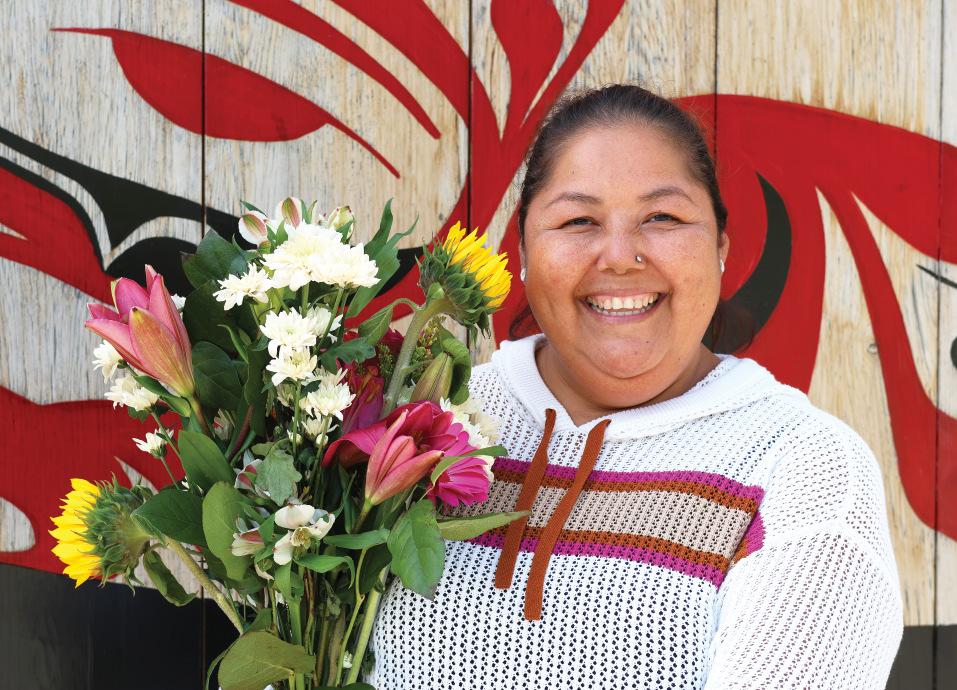
Yuułuʔiłʔatḥ’s Jeneva Touchie beams with a bouquet of flowers she received from the District of Ucluelet after being awarded the honour of Citizen of the Year on July 27 at the Ukee Days fairgrounds. and just connecting. I think that’s what makes a local; how involved you are with everyone around you.”
carriers and fluent speakers. In our community, only one fluent language elder / teacher remains. This makes the work Jeneva is doing both vital and urgent.”
Bruce Greig, Ucluelet’s director of Community Planning, worked with Jeneva on the street sign project, which was unveiled in July 2022.
“She is dedicated to reinvigorating the West Barkley dialect and passionate about getting people to use the language which has its roots in this place,” wrote Greig in an email.


“I’ve seen Jeneva welcome people to join in learning – whether it’s little kids, adults or elders – by engaging them with respect, a lot of humour and always a huge heart. I think she was named Citizen of the Year because people recognize that Jeneva works at connecting people and also connecting people with this place – she’s a community builder,” he continued.
Jeneva attended Ucluelet Elementary School and Ucluelet Secondary School. She went on to achieve a bachelor’s degree in hospitality from Vancouver Island University and a second degree in
Hesquiaht First Nation and Yuułuʔiłʔatḥ elder Nicki Love has known Jeneva since she was a teenager. She says she thinks about Jeneva and her grandmother every time she walks into the Sičquuʔuƛ (Sitch – KHOO – ootl) Theatre in Pacific Rim National Park Reserve’s Kwisitis Visitor Centre.
“If it wasn’t for young people, we would lose it,” said Love. “I remember doing language with her grandma in the early ‘90s and having brief conversations with
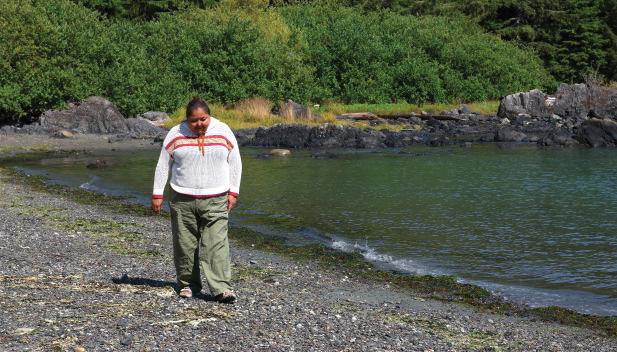
Indigenous language revitalization from the University of Victoria. Next July, she’ll embark on a Masters.
Having lived in Ucluelet her whole life, she is one of the few that can truly claim “local status”.
“We were teasing about this at lunch, if you know where Sky Couch is, are you local?” she laughed. “Everyone knows where Sky Couch is though. I tease my husband because we’ve been together 27 years now and after 20 years, (I tell him) you’ve finally got your local status.”
“I think it just depends. You can really tell who is involved in the community,” said Jeneva, who was a member of Yuułuʔiłʔatḥ Government’s legislature for eight years and is now the nation’s manager of language services. “You can see that commitment to being at events
Yuułuʔiłʔatḥ language keepers and I just remember her saying if you can read the language, if you can read the phonics, you can speak it. That’s the message I kept in my brain forever.”
With support from a Clayoquot Biosphere Trust (CBT) Neighbourhood Small Grant, Jeneva recently hosted a walk around town to introduce folks to the bilingual street signs and share teachings on how to pronounce Nuu-chahnulth words.
“I think there was 20 of us. We just went for a nice little walk, had some snacks and talked about our experience and the signs and how to pronounce them. It was really great. It was fun,” she said.
She plans on hosting another CBT walk and will teach with Parks Canada at Kwisitis Visitor Centre come September.
Nora O’Malley photo
S.
Clay Steell
Ever since the Mount Underwood forest fire cut off power and direct road access to the community of Bamfield andAnacla onAugust 11th, the town has been abuzz with talk on what it all means. For better or worse, Facebook has been the primary conduit for information sharing and discussion. While I’ve personally discussed with other community members the role that climate warming has in making forest fires like this more likely, the discourse online hasn’t seemed to reflect this, which feels like a strange disparity given that we see the impacts of the climate crisis all around us.
While we don’t yet know what caused the spark that lit the Mount Underwood fire, we can be certain that climate warming made it vastly more likely to spread out of control. The evidence is clear that heatwaves on this coast are up to 9°C warmer and 10-times more likely due to climate warming, while summers on average are almost 2°C warmer than last century. Droughts are now far more likely as a result of climate warming as well, which paired with warmer conditions has made forest fires four times more likely to spread out of control, independently of what caused them to start. These conditions are only going to increase as our climate warms, with this coast projected to be 4-9°C warmer and 20-40 per cent drier by 2100, depending on our actions today. Increasing levels of carbon emissions in our atmosphere due to the burning of fossil fuels are unambiguously making our climate warmer.Average global temperature has increased by 1.3°C since pre-industrial times, which may double by 2100, rising to 2°C to 4°C, depending on how soon we stop burning fossil fuels and transition to safer sources of energy. While these global temperature differences sound small, local temperature and weather extremes will be far more severe, jeopardizing ecosystems and communities worldwide.
In addition to climate warming, the legacy of colonial forest mismanagement has also made fires far more likely to spread out of control. Since colonization, a large majority of primary forests have been cut down across this coast and replaced by tree farms, including the area where the Mount Underwood fire has spread.All the while, the forestry industry has shifted from local milling to mechanization and raw log exportation, sending jobs overseas and enriching shareholders while local workers get laid off, with over 50,000 jobs lost provincewide since the late 90s.Along with destroying the pre-existing ecosystem, tree farms grown from clear cuts are far more
likely to burn out of control than primary growth forests. Overlaying the Mount Underwood fire with a map of remaining old growth makes it clear that this fire has burned almost entirely through tree farms or recent clearcuts that have replaced primary forests.
Grimly, the effects of climate warming and clearcutting reinforce each other, creating a well-established feedback loop that makes the effects of each other worse. Clearcutting forests emits huge amounts of carbon into the atmosphere, which will take at least half a century and up to 3 centuries for a tree farm to neutralize through sequestration. This is time we don’t have to spare as our window for a lower-risk future climate narrows, and in which time these secondary forests may be cut down again to harvest, resetting the clock. Thanks to climate warming and clearcutting, all managed forests across Canada now emit more carbon than they sequester (140 million tonnes per year, on average), which compared to other sources would make it the third-largest carbon emitting sector nationally, as much as all passenger cars, trucks, airplanes, and houses combined.
On the flipside, this means that adapting forestry practices can make them less damaging to our future climate, which in turn can make them less likely to burn in the future. While CEOs and shareholders chasing the bottom line are threatened by bringing jobs back to B.C.’s forestry sector, workers stand to benefit from forestry that promotes sustainability and respects Indigenous sovereignty. Sooner or later, Bamfield andAnacla will have power and road access restored, and a sense of normalcy will return. But we’re moving into a future where such normalcy will be constantly threatened and shifted due to the climate crisis. While lowering one’s “carbon footprint” may be impactful if it’s high-emitting, it will do little to reverse systemic reasons that our economy continues to be one of the highest emitting globally, despite shovel-ready pathways to decarbonize that promise to raise standards of living.
To really understand what a forest fire like Mount Underwood means to this community, we must look at what’s in our power to change locally as we move toward a post-fossil fuel economy, and how we can build power towards turning the tide regionally and globally. Whether this is by protecting old growth and reforming forestry practices, or by fighting the BCNDP’s plans to divert renewable energy from our grid to an economically risky and highly-polluting fracked gas (LNG) export industry, we have options to apply our power as a community for a safer and less fiery future.
S. Clay Steell is a marine scientist living in Huu-ay-aht Territory (Bamfield, BC) and works at the intersection of habitat restoration and climate change. He also chairs the Bamfield Huu-ay-aht Community Forest Society.

ActiveAll Stars
Wednesdays from July 16th –August 27th
4841 Redford Street – The Nucii Gymnasium
Every Wednesday 2:00pm – 4:00pm Drop In and join theActiveAll Stars!A fun and supportive gym program for kids aged 5+. TheActiveAll Stars supports a growth mindset, building gross motor skills, team work and positivity. For more information contact Desiree at desiree. sanderson@nuuchahnulth.org or 250724-3939 ext. 5282


&Community Beyond

NCN Mental Health Counselling Tuesdays and Thursdays 8:30am – 4:30pm
4841 Redford Street, PortAlberni
NCN Mental Health Services – DropIn Counselling with Margaret Bird, Registered Clinical Counsellor and Play Therapist. For on and off reserve members of all ages of the Nuu-chahnulth Tribal Council. Call (250) 724-3939 to book your appointment.

27 years as a licensed hair stylist. Able to
25 Years Ago in Ha-Shilth-Sa
Vol. 27 – No. 17 August 24, 2000

Isaak falls first tree in Clayoquot Sound
In the early morning ofAugust 22, 2000, a new era of logging was marked by Isaak falling its first tree. Once bitter opponents, central region First Nations leaders, environmentalists, Isaak Forest Resources staff and many others waited together on the Tofino government dock.An atmosphere of laughter and excitement was felt between the groups awaiting a boat; once on board, the groups mingled, chatted and joked amongst each other.After arriving at Cypress Camp, everyone made a brief struggle to the chosen tree, a large red cedar in theAhousaht territory. Percy Campbell of theAhousaht Nation performed a prayer chant and Louie
Frank Sr. offered a prayer in Nuu-chahnulth language. Faller Joe Corlazzoli, Isaak Forest Resources employee, took less than two minutes to fall the large tree and was met with a round of applause. For the first time since the protests of 1993, trees were being felled in the Clayoquot Sound. Isaak Forest Resources would go on to perform small-scale logging in an environmentally sensitive manner. Western Canada Wilderness Committee purchased part of the red cedar, which was made into cedar boxes to be sold at WCWC offices. Four slices of the stump were saved to be sanded, dated and made into a commemorative display.
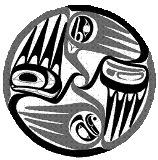
Need work experience? The Port Alberni Friendship Centre is looking for interested applicants for various positions. Call 250-723-8281




Tlu-piich events begin under blazing August heat
Annual Nuu-chah-nulth sports event started on swelting days in the mid 30s, but was cut short by a forest fire
By Eric Plummer Ha-Shilth-Sa Editor
PortAlberni, BC - Under an oppressive August sun, the 2025 edition of the Tlupiich Games got underway onAug. 11 with track and field events at Bob Dailey Stadium.
Scheduled for various PortAlberni venues fromAug. 11-14, events began at the track, with baseball, pool games, basketball, volleyball and canoe races set for the following days. Many of these activities would be cancelled, as an air quality advisory came to theAlberni Valley due to thick smoke from the Mount Underwood forest fire south of PortAlberni. Organizers opted to cut the games short on the afternoon ofAug. 13.
The games started on a day when temperatures reached 35 Celsius in Port Alberni, leading organizers to cut short the relay competitions and call off events at 2 p.m. due to the heat. But track and field was back at Bob Dailey Tuesday morning, with finals scheduled from 8:30 a.m. until 3 p.m.
The opening ceremonies were still held onAug. 11at 5:30 p.m., with a march of groups of participants from Tseshaht, Ditidaht, Huu-ay-aht and Nuchatlaht First Nations, plus family members represented together as the Healing Hearts team. Unlike past opening ceremonies, there was no singing at the gathering due to recent losses in the Tseshaht community. Speakers at the event expressed their condolences.
This marked the 40th year that the summer games have been held in PortAlberni for Nuu-chah-nulth-aht.
“It’s kind of an institution, the Nuuchah-nulth games,” said Judith Sayers, president of the Nuu-chah-nulth Tribal Council, during the opening ceremonies.
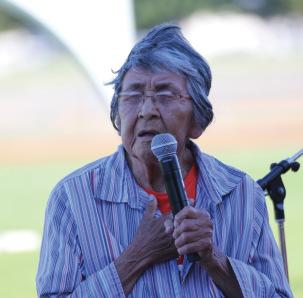







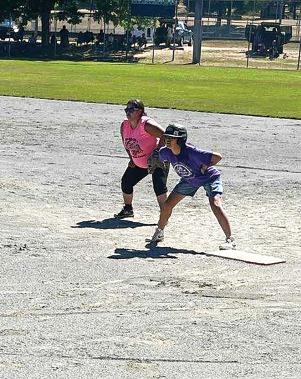

Eric Plummer, Holly Stocking, Chloe Wangler photos Children compete in sprinting races at Bob Dailey Stadium onAug. 11, the first day of the 40th annual Tlu-piich Games. Baseball (below) and basketball followed, until the games were cut short onAug. 13 due to poor air quality from a wildfire.
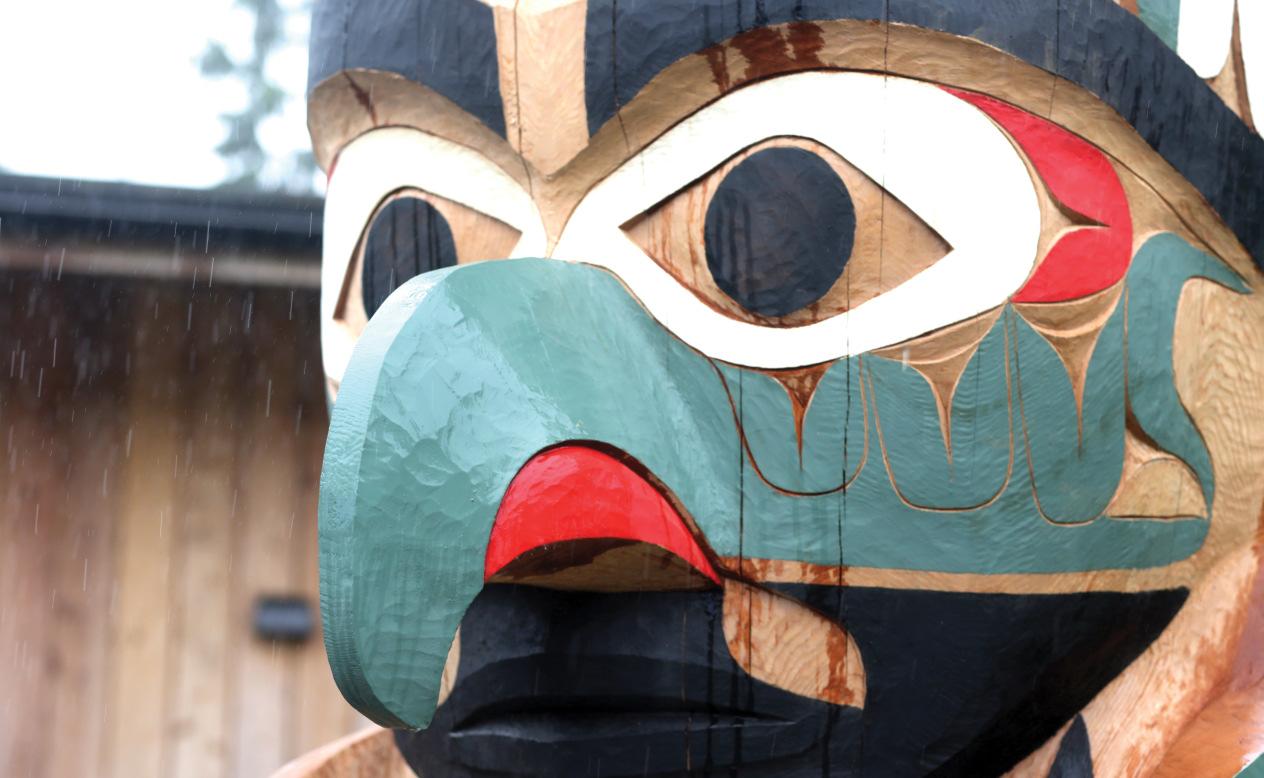
territory,
Totem pole raised for longtime Uchucklesaht leader
Charlie Cootes led First Nation into the modern era, gaining a treaty, real estate and a rejuvenated home village
By Eric Plummer Ha-Shilth-Sa Editor
Ethlateese, BC - With the rain pouring down on the Uchucklesaht village of Ethlateese, young Taylor Johnson carefully circles a newly unveiled totem pole onAug. 15. Her elders watch, reciting a chant in a ceremony to reawaken the pole.
“We have to reopen the eyes,” explained carver Tim Paul, who led a handful of other artists in the totem’s creation over the better part of a year. “We had a closing of the eyes ceremony before travel down here, so we need to reopen the eyes of our grandparent. But also we need to make it come alive.”
On the mid-August morning dozens of others watched, as the rain seemed to come as an answer to a prayer.After a particularly dry spring and summer, forest fires had recently broken out on Vancouver Island, including the explosive Mount Underwood blaze that grew to over 3,400 hectares in a few days north of Ethlateese by theAlberni Inlet.
Including those who watched the young girl circle the freshly carved red cedar was Charlie Cootes Sr. The pole was erected in front of the Ethlateese wellness centre in his honour, recognizing a political career that spanned from 1967 to late 2023 in the service of his nation.
“It’s a small nation with a big footprint,” said the former chief councillor after the ceremony. “I’m so glad that I’m retired because our young people are doing what I was dreaming: stepping up and taking up leadership roles.”
For half a century Cootes was re-elected to represent his nation so many times he came to appear like a permanent fixture in the chief councillor role, leading the small tribe – which currently numbers just over 250 members – into a modern era of self-sufficiency.
Uchucklesaht is among the few First
Nations in British Columbia to adopt a modern-day treaty. ImplementedApril 1, 2011, the Maa-nulth FinalAgreement brought five Nuu-chah-nulth nations out from under the IndianAct, bringing a total of $73.1 million (in 2006 dollars) in capital transfer payments, 24,550 hectares of treaty settlement land and full authority under Canadian law.
Since then, Uchucklesaht made significant property investments in Port Alberni, including opening the $8-million multi-use Thunderbird Building in 2016.
Two years later Uchucklesaht bought the former Redford School, a sprawling complex of office spaces, gymnasium and field that covers an entire city block.
Renamed Nucci, much of the building is being rented by departments of the Nuuchah-nulth Tribal Council, while Uchucklesaht plans to build over 100 housing units in the space behind.
“Make it - if you can - so that by expanding our footprint it makes us self-sustaining,” said Cootes during the celebration. “Our Thunderbird Building is mortgaged by all the apartments that we rent out. Nucci supports itself by all the offices that we rent out.”
Ethlateese has also seen significant development. In recent years all homes in the remote village have been replaced with 14 new units. Now anywhere from half a dozen to as much as 30 people reside in the village at any given time.
At the event Cootes’stepbrother Stan Lucas reflected on how Ethlateese transformed over the long-serving politician’s tenure.
“The last time I was down here was the late ‘60s. There were only three houses down here,” said Lucas. “It’s always a good feeling, the best feeling, especially when the rain comes down like this, to cleanse it, to purify it.”
Overlooking the village are five mountain peaks, known as The Thunderbirds Nest – an area that sees more annual rain-
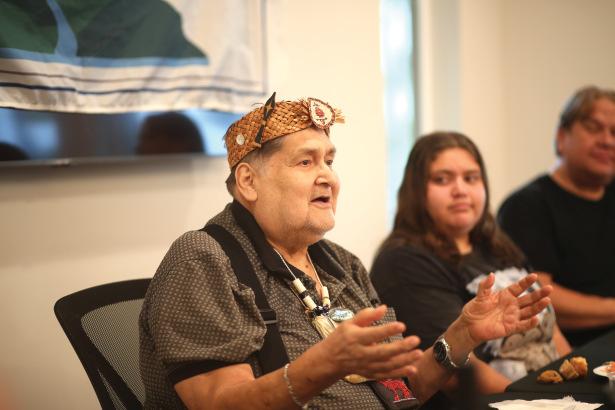
fall than anywhere in NorthAmerica.
During the event Cootes was thanked for his role in protecting The Thunderbirds Nest from being logged, and the pole contains representations of the eldest thunderbird, maamiiqsu, atop the youngest, qałaatik.
“We’re related to nature, our relative,” explained Paul. “We treat and take care for with the utmost power and respect that we have as a people.”
“It’s always, always the greatest honour as an artist to bring history, to bring family cultural teaching alive,” continued the carver. “You stand in front of it and you feel the power and the presence of ancestors gone before us.”
For the first time, the ceremony also brought Cootes a Nuu-chah-nulth name, muuc^in%aq+.
Pronounced ‘moo-chin-achlt’, it means ‘four directions’.
“I’m so grateful to have all the people who are here today to experience this,” he said.

Eric Plummer photos
Representing two thunderbirds who have a nest in Uchucklesaht
a totem pole was unveiled in Ethlateese onAug. 15 in recognition of the contributions of former chief councillor Charlie Cootes.
Charlie Cootes speaks at a gathering for him held in Ethlateese onAug. 15.

